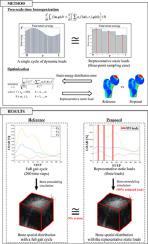Computer Methods and Programs in Biomedicine ( IF 4.9 ) Pub Date : 2020-12-31 , DOI: 10.1016/j.cmpb.2020.105924 Bong Ju Chun , In Gwun Jang

|
Background and Objective
Bone has the self-optimizing capability to adjust its structure in order to efficiently support external loads. Bone remodeling simulations have been developed to reflect the above characteristics in a more effective way. In most studies, however, only a set of static loads have been empirically determined although both static and dynamic loads affect bone remodeling phenomenon. The goal of this study is to determine the representative static loads (RSLs) to efficiently consider the statically equivalent effect of cyclically repeated dynamic loads on bone remodeling simulation.
Methods
Based on the concept of two-scale approach, the RSLs for the gait cycles are determined from five subjects. First, the gait profiles at the hip joint are selected from the public database and then are preprocessed. The finite element model of the proximal femur is constructed from the clinical CT scan data to determine the strain energy distribution during the gait cycles. An optimization problem is formulated to determine the candidate static loads that minimize the errors of the spatial strain energy distribution for five gait profiles. Then, all candidate static loads from five gait profiles are partitioned into multiple clusters. The RSLs and the corresponding coefficients can be determined at the center of the densest cluster. For verification, topology optimization is separately conducted with the whole gait cycle (reference), empirically determined loads (conventional), and the RSLs (proposed). The strain energy density-based bone remodeling simulation is also conducted for another comparison.
Results
For the gait loads, the use of the RSLs enables a 99% reduction of the function calls with negligible errors in the bone spatial distribution (6.75% for two representative static loads and 6.24% for three representative static loads) and apparent stiffness (4.84% for two representative static loads and 4.47% for three representative static loads), compared with the use of a whole gait cycle as reference.
Conclusion
This study shows the feasibility of the RSLs and provides a theoretical foundation for investigating the relationship between static and dynamic loads in the aspect of bone remodeling simulation.
中文翻译:

确定周期性重复动载荷的代表性静载荷:以步态载荷进行骨重塑模拟的案例研究
背景与目的
骨具有自我优化的能力,可以调整其结构以有效地支撑外部载荷。已经开发了骨骼重塑模拟以更有效的方式反映上述特征。然而,在大多数研究中,虽然静态和动态载荷都会影响骨骼重塑现象,但根据经验仅确定了一组静态载荷。这项研究的目的是确定代表性的静态载荷(RSL),以有效地考虑周期性重复的动态载荷对骨骼重塑模拟的静态等效影响。
方法
基于两尺度方法的概念,步态周期的RSL由五个对象确定。首先,从公共数据库中选择髋关节的步态轮廓,然后进行预处理。根据临床CT扫描数据构建股骨近端的有限元模型,以确定步态周期中的应变能分布。制定了一个优化问题来确定候选静载荷,该静载荷使五个步态剖面的空间应变能分布的误差最小。然后,将来自五个步态轮廓的所有候选静态载荷划分为多个群集。可以在最密集簇的中心确定RSL和相应的系数。为了验证,拓扑优化是在整个步态周期(参考)中分别进行的,根据经验确定的负载(常规)和RSL(建议)。还进行了基于应变能密度的骨骼重塑仿真,以进行另一个比较。
结果
对于步态负载,使用RSL可使功能调用减少99%,而骨骼空间分布的误差可忽略不计(两个代表性静态载荷为6.75%,三个代表性静态载荷为6.24%)和视在刚度(4.84%与使用整个步态周期作为参考相比,两个典型的静态载荷为3%,三个典型的静态载荷为4.47%)。
结论
这项研究表明了RSL的可行性,并为研究骨骼重塑仿真方面的静态和动态载荷之间的关系提供了理论基础。











































 京公网安备 11010802027423号
京公网安备 11010802027423号